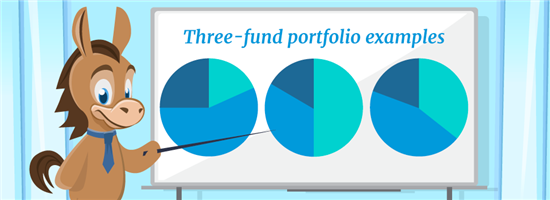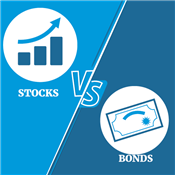Three Fund Portfolio
Investing can be simple and still provide high returns. A three-fund portfolio is a good option for beginner and DIY investors who want to be hands-off.
 |
Investing can feel intimidating and expensive when you don't understand it. Overcomplicating things often leads to bad investment decisions and more lost money.
If you feel overwhelmed by too many choices, the three-fund portfolio could be the right strategy for you. It's a simple, low-cost way to invest for beginners and experienced investors.
Read on to learn how the three-fund portfolio works and how to create one.
What Is the Three-Fund Portfolio?
The concept of the three-fund portfolio was created by John Bogle, founder of Vanguard. It's an investment strategy where your portfolio is made up of just three index funds. This keeps things simple and low risk, while still being diversified.
The typical three-fund portfolio consists of:
- A U.S. stocks index fund
- An international stocks index fund
- A U.S. bonds index fund
Index funds are used because they usually have lower fees than actively managed funds. You can invest in index funds either through ETFs or mutual funds (we'll go over the difference in a bit).
This strategy is ideal for hands-off and beginner investors. There's not much active management needed. You just invest in 3 funds and sit back and let the investments do their thing.
Index funds are a basket of securities that track a specific market index. For example, an index fund that tracks the S&P 500 is made up of the 500 largest U.S. companies.
Pros of a Three-Fund Portfolio
Here are 4 reasons why the three-fund portfolio strategy is a good way to invest.
- It's simple.
You don't have to worry about picking individual company stocks and monitoring their performance. Having just 3 funds makes managing your portfolio incredibly easy. - Diversification.
Each fund consists of hundreds of different stocks. And by investing in US stocks, US bonds, and international stocks, you're diversified across different markets and risk levels. - Easy to rebalance.
With just 3 funds, it's easy to rebalance in order to maintain risk tolerance. Just decide the percentage for each fund (for example, 40% US stocks, 30% global stocks, 30% US bonds), and readjust if your portfolio allocation drifts. - Match market returns.
Index funds are designed to match a market index (like the S&P 500). It's risky and difficult for DIY investors to try to beat the market. But investing in an index fund guarantees that you match it.
Cons of a Three-Fund Portfolio
Three-fund portfolios are generally a good bet for most people. However, one potential downside is choosing funds with high expense ratios.
As long as you choose funds with low expense ratios, you'll be fine and your profits will be higher.
Both ETFs and mutual funds have a fee called the expense ratio. This is the operational costs of the fund, including costs for managers, admin, and marketing. This fee is taken out of your investment, so it eats into your profits.
Index funds have much lower expense ratios since they're passively managed. Active funds can have expense ratios between 0.5% - 2% (or higher). But index funds are usually lower between 0.015% - 0.2%. Some even have no expense ratio at all.
How Do You Create a Three-Fund Portfolio?
 |
As the name states, you need three funds to create a three-fund portfolio. Here are the general steps:
- Decide if you want to invest in ETFs or mutual funds
- Determine your asset allocation (stocks vs bonds split)
- Choose index funds with low expense ratios and excellent diversification
We'll go into more detail for each of these points.
Step #1: Choose ETFs or Mutual Funds
As previously mentioned, you can invest in index funds through either exchange traded funds (ETFs) or mutual funds. They work a little differently. Here's a quick explanation.
- ETFs are purchased in shares and traded throughout the day on the stock market. They're usually available on most investment apps, making them more accessible.
A lot of brokerages now even support fractional shares, so you can invest in ETFs with just a few bucks. This makes it ideal for beginners without a lot of money to start.
- Mutual funds are usually purchased in dollar amounts and trade just once a day at closing. You can purchase them directly through the mutual fund company (such as Vanguard or Fidelity) or through a brokerage, though not all offer mutual funds.
A lot of mutual funds have a $1,000 - $3,000 minimum investment. Though there are a number of $0-minimum mutual funds now.
There's no rule that you need to stick to all mutual funds or ETFs. You can choose to invest in a US stocks ETF and international stocks ETF, and US bonds mutual fund.
Step #2: Determine An Asset Allocation
So how do you know how much to purchase for each fund? This is called asset allocation.
Your ideal allocation depends on your age and risk tolerance. The younger you are, the more risk you can afford. Stocks are more volatile than bonds, but have higher growth potential. If you want less risk, you'll want to increase the bonds percentage.
Here are a few examples of what your portfolio could look like.
- Aggressive (80/20)
50% US stocks, 30% international stocks, and 20% US bonds. This aggressive portfolio suits younger investors with high risk tolerance and a long time horizon. - Moderate (60/40)
40% US stocks, 20% international stocks, and 40% US bonds. This is a middle-of-the-road portfolio - not too aggressive and not too passive. - Conservative (30/70)
20% US stocks, 10% international stocks, and 70% US bonds. This is a conservative portfolio that's ideal for those closer to retirement age.
For example, if you're in your 30s, you may want to go for an aggressive approach. If you have $1,000 to invest, you can put $500 in a US stocks index fund, $300 in an international stocks index fund, and $200 in a US bonds index fund.
Keep in mind that you'll be in charge of reallocating your assets. As you get closer to retirement, you'll want to be more conservative and gradually shift your allocation to more bonds.
After choosing your three funds, track their historical performance by looking back at the last 5 - 10 years. Once you know the annual historical returns, you can adjust according to your chosen allocation to determine the historical returns. This can help you choose the right funds for your investment.
Once you've determined your asset allocation, it's time for the final step: Picking your funds. Below, we cover some popular funds to consider.
Popular ETFs for Three-Fund Portfolio
Your three-fund portfolio should consist of low-cost funds that encompass the entire market. Here are some popular funds in each category.
US stocks ETFs:
- Vanguard S&P 500 ETF (VOO)
- SPDR S&P 500 ETF (SPY)
- iShares Core S&P 500 ETF (IVV)
International stocks ETFs:
- Vanguard Total International Stock ETF (VXUS)
- Vanguard FTSE All-World ex-US ETF (VEU)
- iShares Core MSCI Total International Stock ETF (IXUS)
US bonds ETFs:
- Vanguard Total Bond Market ETF (BND)
- iShares Core US Aggregate Bond ETF (AGG)
- iShares Core Total USD Bond Market ETF (IUSB)
We provide these as examples only. Please do your own diligence and research to make sure it's the right investment for you.
Popular Mutual Funds for Three-Fund Portfolio
If you'd like to invest in mutual funds instead, here are some examples of popular low-cost mutual funds.
US stocks mutual funds:
- Vanguard Total Stock Market Index Fund (VTSAX)
- Fidelity Total Market Index (FSKAX)
- Schwab Total Stock Market Index (SWTSX)
International stocks mutual funds:
- Vanguard Total International Stock Index Fund (VTIAX)
- Fidelity Total International Index Fund (FTIHX)
- Schwab International Index (SWISX)
US bonds mutual funds:
- Vanguard Total Bond Market Index Fund (VBTLX)
- Fidelity US Bond Index Fund (FXNAX)
- Schwab US Aggregate Bond Index Fund (SWAGX)
How Many Funds Make an Ideal Portfolio?
While there's no magic number, many investors still ask: How many funds make an ideal portfolio?
Experts agree that 20+ stocks or a mix of stocks and bonds make up an ideal portfolio, but what about funds?
Since they are already made up of many stocks or bonds, do you need more than one fund? Some experts think one is plenty, while others believe diversifying even more is ideal.
The three-fund portfolio is the compromise. It offers exposure to domestic and international stocks, plus bonds, giving you a well-diversified portfolio.
6 Tips Before Investing in a Three-Fund Portfolio
Before you start a three-fund portfolio, there are some important tips you should understand. While anyone can set up a three-fund portfolio, it requires careful thought and an understanding of how the investments work. Make sure that your portfolio is good for your personal financial goals.
Use these five tips before investing in a three-fund portfolio:
- Know Your Goals
Think about your "why." What is the reason you are investing? Are you saving for retirement, another financial goal, or just want your money to grow?If you have a time-sensitive goal, it will help determine which asset allocation is best for you. The further you are away from your goal, the more aggressively you can invest, and vice versa.
- Research Your Brokerage Options
If this is your first brokerage account, research your options carefully. See which brokerage offers the flexibility, fees, and investments you want before choosing a broker.For beginners, there are lots of micro-investment apps that are less intimidating than traditional investment platforms.
- Choose an Asset Allocation
It's not enough to choose three funds - you need to know what sort of allocation you want/need. Are you thinking about an aggressive portfolio, such as the 80/20 portfolio, or something more conservative like 60/40 or even less?Decide what risk level you're comfortable with, and know that you can always change it. As your goals, lifestyle, or financial needs change, you can adjust accordingly.
- Note the costs
As mentioned before, it's important to look for funds with low expense ratios, since this fee will reduce your earnings. We recommend to stick with index funds with expense ratios less than 0.2%. There are lots available with even less. - Regularly Contribute to Your Portfolio
Don't make the mistake of setting up your portfolio and then forgetting about it. The only way it will grow the way you want is with regular contributions. If you can't trust yourself to make them manually, set up automatic contributions on a weekly, bi-weekly, or monthly basis. - Monitor Your Progress
Always monitor your progress, but not to the point that it's driving you crazy. You'll need to periodically rebalance your portfolio to maintain your ideal asset allocation. And as you get closer to the time horizon of your goal, you'll need to shift to a larger percentage of bonds.
Other Alternatives
The One-Fund Portfolio
The one fund portfolio is an investment in a total market index, such as the Vanguard Total Stock Market Index Fund. This fund mimics the S&P 500 and encompasses the entire market.
The Two-Fund Portfolio
If you'd rather diversify your investments a bit, the one fund portfolio may not be enough. There's a lot of risk in putting all your eggs in one basket. Instead, you can invest in a stock index fund and a bond index fund to make things a little more conservative.
The Four-Fund Portfolio
If the three-fund portfolio doesn't feel diversified enough, you can add a fourth fund - an international bond index fund. This way, you have a domestic stock and bond fund investment and an international stock and bond investment for even greater returns.
The Five-Fund Portfolio
The five-fund portfolio adds one more element - a real estate investment trust (REIT). While it's still a fund, it isn't tied into the stock market, which works as a hedge against the volatility of the market.
Bottom Line: Should You Have a Three-Fund Portfolio?
A three-fund portfolio can be an excellent way for beginners to break into investing or DIY investors who want a "lazy approach" to investing. It's not the only way to invest, and there's no guarantee of large profits, but it can be the segue investors need into other more significant investments down the road.
Before you invest, make sure you're clear on your objectives, and if you are the type who wants someone to manage the funds for them, the three-fund portfolio isn't for you. It's for the investor who wants a "lazy" but somewhat hands-on approach when it comes to reallocating the portfolio when it's time.
Write to Sam Hawrylack at feedback@creditdonkey.com. Follow us on Twitter and Facebook for our latest posts.
Note: This website is made possible through financial relationships with some of the products and services mentioned on this site. We may receive compensation if you shop through links in our content. You do not have to use our links, but you help support CreditDonkey if you do.
|
|
| ||||||
|
|
|












